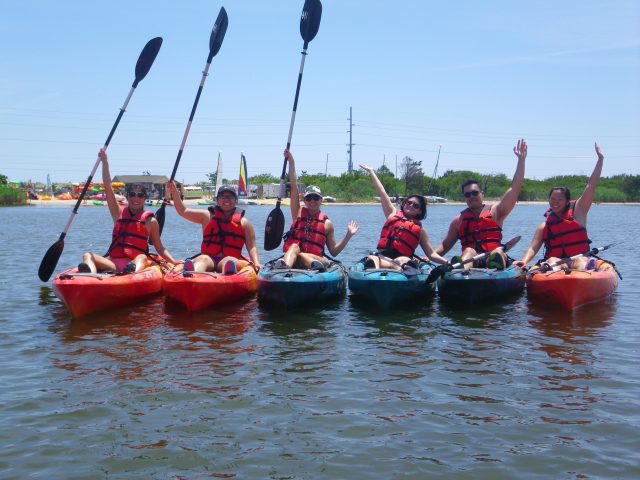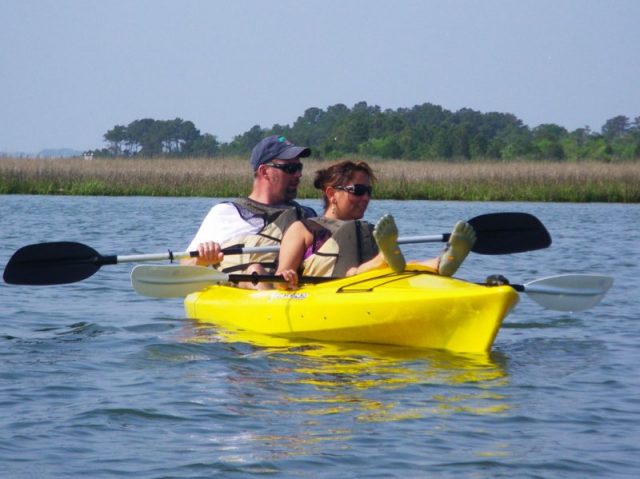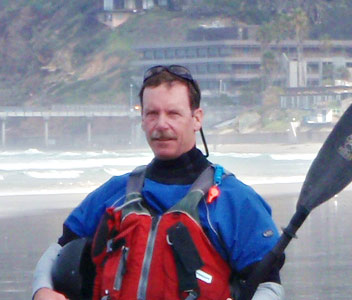The essence of kayaking is simple: Just grab a paddle and go. But how you grab that paddle can be the difference between a journey that feels effortless, and one that ends in blisters, sore joints, and aching muscles.
Here are the five most common grip mistakes I see and simple ways to fix them.
Problem 1: Death Grip
White knuckling the paddle causes several problems:
1) Your forearms tire quickly. Try grabbing a broom handle and squeezing it in one hand for 5 minutes. I guarantee your arm will get tired!
2) Using your weaker forearm and hand muscles prohibits you from using your larger, stronger core muscles that are essential for efficient paddling.
3) Blisters! Whenever someone says they are getting a blister, my first response is to tell them to relax their grip.
Solution: Get into vacation mode and relax that beltway grip! A light grip is one of the most important aspects of a successful paddle stroke. To train yourself to relax, try opening your fingers on the ‘out-of-water-phase’ of your stroke while pushing with your palm. This will force you to release your grip and also reinforce the often over-looked pushing phase of the stroke.
Problem 2: Placing your hands too far apart or too close together on the paddle shaft
If you hold your paddle with a grip that’s too wide, it will in essence make your paddle shorter. Although this may give you a little more power, the resulting shorter paddle stroke is much less efficient. If you are constantly hitting your knuckles on the side of the kayak, most likely your grip is too wide.
Holding your paddle with your hands too close together gives you a longer paddle stroke, but you lose power. In addition, your paddle will arc widely with each stroke, causing your kayak to yawl back and forth—very inefficient!
Solution: Pretend you’re doing your morning pull-ups and your paddle is the bar. This is the ideal width for your hands.
Problem 3: Holding the paddle with the blade upside down

Most of today’s paddles are asymmetrical, meaning the blade has a long side and a short side. When paddling, your blade enters the water at an angle. An asymmetrical blade ensures there is equal pressure on both the top and bottom of the blade. If you hold the paddle with the long side down, it will want to twist, or flutter, as you take a stroke. You’ll then grip the paddle too tightly to keep it from fluttering, which, as I mentioned above in “Death Grip” is not good.
Solution: Take a good look at your paddle and make sure to hold it with the long edge on top. This will ensure that it easily stays in your hands. (Don’t be embarrassed if you’ve made this mistake in the past. I’ve seen people with brand new $400 carbon fiber paddles holding them upside down!)
Problem 4: Holding the paddle backwards
Today’s paddles have a curvature or spoon shape to them. This allows you to better grip or “catch” the water. In an ideal paddle stroke, the paddle, once planted in the water, does not move. Instead, the kayak moves up to the paddle. After all, we want to move the kayak, not the water. A backwards paddle is not the end of the world. But it affects efficiency. And, of course, you can’t look cool with a backwards paddle.
Solution: Make sure the scoop of the blade faces you. Again, don’t be embarrassed about this common mistake. Many times, as renters paddle away from our beach, I’ll need to tell them their paddle is upside down. They’ll rotate it so the long edge is on top. Then I’ll say now it’s backwards. So they’ll roll it over again, and I say it’s upside down again. After a few times and some laughs, I’ll tell them they need to twirl the entire paddle around like a baton and then they get it.
Problem 5: Grip not centered on the paddle shaft
This is also very common. Not holding your hands equidistant from the blades will cause one side to be longer than the other. The longer the paddle, the more turning influence it will give with each stroke. If you’re paddling with one long side and one short side, the kayak will turn away from the long side. This is inefficient and frustrating, as you’ll be making constant adjustments.
Solution: If you have a two-piece paddle, the joint is going to be the center of the shaft. Make sure your hands are equidistant from the seam. A one-piece paddle is harder to judge, but eyeball the distance from the blade to your hands and make sure it is the same.
Unless you’re paddling class V whitewater or down an exposed coastline, holding your paddle incorrectly is not the end of the world. But holding your paddle properly will make your paddling experience a lot more enjoyable and will allow you to go further, faster, and straighter with less work.
Happy Paddling!

By Mitch Mitchell
ACA Level 4 Open Water Instructor Trainer
ACA Level 2 Paddleboard Instructor Trainer
USCG Captain
